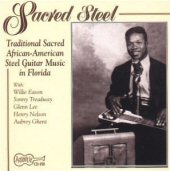 • VARIOUS ARTISTS: SACRED STEEL (Arhoolie) (1997)
• VARIOUS ARTISTS: SACRED STEEL (Arhoolie) (1997)
Founded in 1903 by Mary Magdalena Lewis Tate (1871-1930), the Church of the Living God, the Pillar and Ground of the Truth Without Controversy subscribed to the Holiness doctrine of Salvation as taught by John Wesley. Tate had earlier founded the Latter Day Church of the Foundation of True Holiness and Sanctification, becoming the first African-American woman to establish a Holiness church in the U.S.A. In 1908, inspired by the Azusa Street revival, Tate began to incorporate Pentecostal doctrine, and her churches moved under the banner of Holiness-Pentecostal.
Originally based on the east coast, the denomination spread throughout the States. After Tate’s death in 1930 the church split into three entities, two of which, the ‘Keith Dominion’ and the ‘Jewel Dominion,’ feature steel guitar as the lead instrument in worship services.
Subtitled ‘Traditional Sacred African-American Steel Guitar Music in Florida,’ what sounds like a curio turns out to be an delight. Sacred Steel documents a whole music scene which has thrived for over half a century virtually unnoticed by music critics.
The steel guitar, first popularized in the 1930s through Hawaiian music, is an electric instrument which sounds somewhat like a guitar, but has many distinctive features. It can produce sounds that echo human voice: bass strings can sound like low moans, and higher registers can resemble a woman’s voice. The first were known as "lap steels” which were positioned on the player’s lap, or more often mounted on telescoping legs.
Pedal steels came later. This instrument includes pedals, which requires to player to sit down while playing. Pedal steel was an integral part of the country music sound in the mid part of this century. The lap steel was introduced into the Keith Dominion in the late 1930s and quickly gained acceptance, eventually becoming lead instrument in worship services. Today both the lap and pedal steels are used.
Arranged into studio sessions and church services, every track, whether up-tempo praise, instrumental, hymn or spiritual, is first rate. Accompaniment is a basic drum set, guitar and occasional bass. Henry Nelson’s ‘Praise the Lord Everybody’ brings to mind the Yardbirds’ rave ups. Glenn Lee offers ‘Joyful Sounds,’ which could almost pass for a pop tune. Reverend Aubrey Ghent, a second generation steel player, is in demand as both a preacher and player. Much of this music is laid back, tasty reads on traditional hymns
This stuff swings. It’s infectious. And there’s little chance of the form dying out in the near future. The music is undergoing change, as new players bring fresh ideas to the mold, but the originals are still playing. From Willie Claude Eason, who is credited as being the first to play gospel music on steel (his original composition, ‘Franklin D. Roosevelt, a Poor Man’s Friend’ is included here) to Glenn R. Lee, still in his twenties, each has an individual voice. It’s no surprise to hear pop melodies incorporated into solos.
There’s no sense of this being an updated version of an old sound. By recording young and old players we get an evenhanded look at the tradition.
The generous playing time of 74 minutes still leaves the listener wanting more. None of the performers’ names is familiar to music fans, but each merits further investigation.
As if the music weren’t enough to justify purchase, Arhoolie has included a 32 page booklet, including essays on the history of the denomination, the steel guitar tradition within those churches and copious notes on the musicians and songs included.
© John Cody 1998